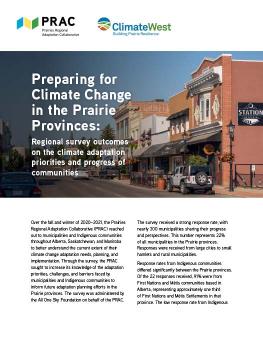
Preparing for Climate Change in the Prairie Provinces
Regional survey outcomes on the climate adaptation priorities and progress of communities
Municipalities and Indigenous communities throughout the Prairie provinces are increasingly observing and experiencing the impacts of changes in their climate. To better understand the concerns of these communities and their progress in preparing for the impacts of climate change, a joint survey was undertaken in Alberta, Saskatchewan, and Manitoba during the fall and winter of 2020–21. The survey was conducted by the Prairies Regional Adaptation Collaborative, for which IISD served as secretariat between 2016 and 2021.
-
Prairie communities are facing more extreme weather events: over 80% of survey respondents shared that their community had experienced one or more unusual extreme weather or weather-related events in the past decade.
-
Although Prairie communities are thinking about climate change, recent survey results indicate that only 5% of responding communities have completed a formal adaptation plan or strategy.
-
Prairie communities identified the need for greater technical and financial support to advance their understanding of climate change and prepare for its impacts.
More than 300 municipalities—or nearly a quarter of all municipalities in the Prairie provinces—responded to the survey. Along with responses received from Indigenous communities within the region, the survey outcomes provide insights into the extent to which Prairie communities have recently experienced unusual extreme weather events and their level of concern about how changing climate risks may impact their infrastructure, community members, and local industries. Most of the surveyed communities expressed concern about the consequences of a changing climate and about one in three indicated that they are taking steps to prepare for these impacts. However, a significant proportion of communities—particularly smaller municipalities—have not yet started to understand how climate change could affect them and taken steps to reduce these risks. Moreover, of the total survey respondents, only about 8% stated that their community had completed a climate change risk and vulnerability assessment, and about 5% had completed a formal climate adaptation plan or strategy.
Survey respondents identified significant barriers to initiating and undertaking preparations for climate change, such as limited staff time and skills, as well as a lack of financial resources. They also provided guidance on the type of technical data and support they need to better understand climate change risks and engage in planned adaptation.
This brief captures key messages that emerged from the survey, which are expected to inform future adaptation planning efforts in the Prairie provinces.
Participating experts
You might also be interested in
From Flooding to Fire: How the Town of Canmore is preparing for climate change
This case study outlines the Town of Canmore's climate change adaptation planning process and the tool that supported it, the Climate Resilience Express tool.
Partners in Climate Action: How Beardy's and Okemasis' Cree Nation is addressing flood-related risks through knowledge sharing and collaboration
This case study outlines Beardy’s and Okemasis’ Cree Nation’s climate change adaptation planning process and the tool that supported it, the Pathways to Climate Change Resilience Guidebook.
A Case for Adaptation: Preparing for Climate Disasters in Manitoba
Recent catastrophic events across the Prairies have given scientists reasons to believe more frequent, extreme events like floods, forest fires, and storms are the most immediate climate risk threatening these areas.
ClimateWest launches to support adaptation to climate change on the prairies
A changing climate will have a significant impact on the Canadian prairies and there is a need for more proactive adaptation and resilience planning.